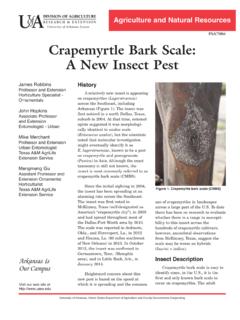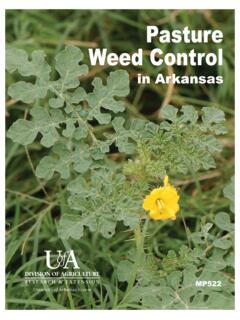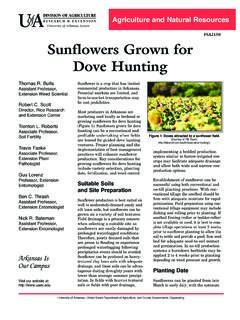Transcription of Chapter 8 - Harvesting Grain Sorghum - Grain …
1 8 - Harvesting Grain Sorghum Gary Huitink Grain Sorghum challenges a combine operator s skills more than any other Grain grown in Arkansas. With a properly equipped and well-maintained combine, an alert operator can reduce Grain Sorghum gathering and separation losses. A capable combine operator can harvest 95 percent of the total yield in a uniformly-mature, standing crop. Separation ( Grain leaving the back of the combine) is the most frequent source of high harvest loss. If gathering is complicated by heights, gathering loss may become much more costly than separation loss. lodging, uneven ripening or differing head Fine-tuning a combine for Grain Sorghum can easily provide $25 to $50 more income per acre.
2 It does not cost any more to do an expert job. Reducing field loss amounts to more profit. Moisture Early harvest reduces the risk of field loss due to Grain shatter or lodged heads or damage due to birds, molds or sprouted kernels. Humid weather often delays field drying in Arkansas, especially after Grain Sorghum reaches 20 percent moisture content. Grain Sorghum requires high temperatures and low ambient air humidity to allow Grain moisture to dry in the field; quality may degrade during periods of high moisture. Market dockage for high Grain moisture, crop characteristics and weather conditions are important factors that influence when to begin harvest. Discounts for Grain Sorghum moisture begin above 14 percent moisture content.
3 Penalties for foreign material, sprouted kernels or mold are factors that may influence harvest timing. In addition, consider your capacity to harvest, handle and dry Grain Sorghum during a time when other crops may be maturing and potentially competing for the same Harvesting equipment. To prevent costly harvest delays or moisture discounts, provisions for drying Grain Sorghum should be made well before harvest. Market penalties for high Grain moisture may encourage drying Grain Sorghum on the farm. To obtain quality Grain and safe long-term storage, plan enough capacity to dry Grain Sorghum to 12 percent moisture content. Twenty percent moisture content is a good recommendation for starting to cut if the heads are uniformly ripe.
4 Field loss and kernel damage are normally lowest at this Grain moisture level. Cut a sample to adjust the combine and then count field loss. If counts reveal that total field loss is below 5 percent of the Grain yield, harvest that Grain Sorghum rapidly. Delaying harvest to reduce the cost of drying Grain Sorghum is likely to be offset by increased field loss and Grain quality reduction. The greatest profit will likely result from start ing harvest between 17 and 20 percent moisture content. Exposure to weather risks, field loss and kernel damage are compelling reasons to drying facilities/market penalties and varietal Timing Grain Sorghum harvest is equally as important as timing rice harvest in Arkansas.
5 Complete Grain Sorghum harvest before it reaches 14 percent moisture. Harvest capacity, characteristics influence this range slightly. If charcoal rot is evident or lodging is a potential threat, harvest without delay. Wind and storms have caused severe field losses of 22, 39 and, in a bad storm, 53 percent of the Grain Sorghum yield in experiments. The larger heads are most prone to lodge, should adverse weather occur before harvest is completed. Note the Gathering comments in the next section. 51 If field loss counts indicate that gathering loss is only a few percent of the yield and threshing and separation losses are high, evaluate the reason. Threshing and separation loss typically are near minimum at 20 percent moisture content.
6 However, the chaffer sieve may become overloaded without much warning. If the combine is adjusted properly and is in good repair, reducing forward speed or delaying harvest until the Grain dries more are two possible remedies/options. Allowing a field to dry down to 17 percent moisture has proven profitable if this contributes to a reduction of the green leaf fraction on the chaffer sieve. If uneven Grain maturity is evident, it is questionable whether delaying harvest will improve income. If the stalks are drying and open weather with low relative humidity is expected near term, it may be profitable to watchfully wait. Cut a sample and wait two or three days and cut another sample.
7 The trend of moisture content and the field Grain loss in several samples will confirm whether to delay harvest further. Fields that have heads well above the flag leaf dry more rapidly. Significant periods of low relative air humidity will hasten Grain drying in the field. Weigh the potential for adverse weather that may cause lodging, shatter or kernel deterioration should you delay harvest. During a damp season with heavy dews and some foggy days, Grain Sorghum weathers and kernels may sprout, potentially penalizing a grower by putting it in sample grade. Quality reductions due to sprouted kernels, mold or broken kernels may often lower Grain one Grade Number. Applying a pre-harvest desiccant application dries the leaves and weeds but the effect on Grain moisture content can rarely be measured.
8 If using a desiccant reduces the green foliage (weeds or Grain Sorghum leaves) that will enter the combine and speeds your combine, apply a labeled desiccant on that basis. However, stalk deterioration begins when the desiccant is applied. The Grain Sorghum acreage that is treated should match your harvest capacity. This is due to the potential for stalk deterioration to increase Grain shatter and lodging, if the treated field isn t harvested within a week or, at most, two weeks after desiccation. Expecting a desiccant to accelerate field Grain drying is unrealistic with typical Arkansas weather. Gathering Grain Sorghum can be harvested with a Grain header (rigid cutterbar), preferably with guard extensions (Figure 8-1).
9 Typically, guard extensions are attached to every other guard in standing Grain Sorghum . Guard extensions provide support to guide more heads into the header in order to reduce gathering loss. Excellent cutterbar maintenance and adjustments are vital. Cut just below the heads to minimize the stem and leaf entering the combine, even if an occasional head isn t gathered. Total field loss is typically lower if the thresher can separate the Grain well without excess foliage entering the combine. Constantly adjust the cutterbar height to avoid overloading the combine separator with flag leaves; thus, restricting its capacity to harvest Grain Sorghum . Grain Sorghum heads that extend well above the foliage are the biggest factor in maintaining a high proportion of Grain in the separator.
10 But an excellent operator must constantly adjust the header height in Grain Sorghum with variable head heights. Figure 8-1. Guard extension, usually attached to every other guard, for Grain Sorghum . At the proper reel speed/forward speed ratio, heads move smoothly across the cutterbar into the platform. Adjust reel speed so the pickup finger speed is 15 to 25 percent faster than the forward speed in order to minimize gathering loss. A slow reel speed, relative to travel, allows heads to fall forward over the cutterbar. Excessive reel speed, low reel position and cutting too low contribute to heads flipping over the reel bats. If the Grain heads vary throughout a wide height range, fastening a baffle or extension above the reel bats may help to control the taller heads and reduce the loss of dropped heads.











![INDEX [westwardparts.com]](/cache/preview/0/c/e/3/1/6/b/6/thumb-0ce316b69830d74b7a9bdf2d99926264.jpg)